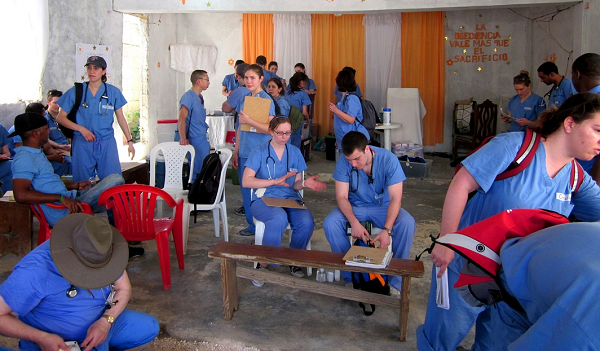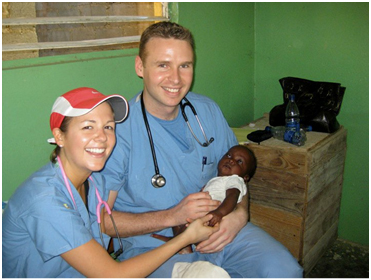 The care teams set up mobile clinics to treat workers in the bateys on sugar plantations in the Dominican Republic. |
What began with a small group of medical students interested in experiencing international medicine has evolved into an interprofessional medical mission that provides more than 1,500 patients with the only medical care they may receive in a year. At the same time, it changes the lives of the students and preceptors who participate.
Launched in 2006 by the School of Medicine (SOM) International Medicine Interest Group, the spring break trip to the Dominican Republic has grown into an interprofessional educational experience that begins many months before the students and preceptors actually board a plane bound for La Romana, the Dominican Republic capital. In its first year, just eight medical students participated in the six-day trip, which was planned in just eight weeks. This year, as a result of growing student interest across all three schools, planning began last fall and the mission took place over two weeks, with seven nursing students, 33 medical students and three MD/PhD students (plus one undergraduate student) and 15 preceptors, including SOM and Graduate School of Nursing (GSN) faculty, taking part. Because of the larger number of care teams, more clinics were held than in years past. The GSN and second-year medical students all participated during the first week of the trip, when their spring break took place.
The students were divided into care teams that headed out each morning to the bateys—small villages on sugar cane plantations where workers live—to set up mobile clinics. As happens every year, the clinics took place in whatever space was available—sometimes in schools or churches or even someone’s yard. Most of the workers seen would not otherwise have access to care. When the student/preceptor care teams arrived each day to set up, patients were already lined up to see them.
Each clinic consisted of stations that perform different aspects of the patient visit—intake, vitals, patient interview and diagnosis. The stations were largely staffed by students, as well as local volunteers who served as linguistic and cultural interpreters. Preceptors, most of whom were doctors and nurse practitioners from UMMS and UMass Memorial Medical Center, circulated throughout the clinic, visiting all the stations. All cases were reviewed and signed off on by a preceptor. Among the preceptors on the second week of this year’s trip was Russell Wolf, MD, whose daughter, first-year med student Molly Wolf, was also on the trip. “I got to sign off on one of her charts, a rare treat for a dad!” said Dr. Wolf.

GSN student Caitlin Jolda and SOM student Mike Grant worked on interprofessional care teams during their recent medical mission to the Dominican Republic.
Since its inception, the success of the D.R. trip has resulted from a partnership with Good Samaritan Hospital—Good Sam for short—in La Romana. Michele Pugnaire, MD, senior associate dean of educational affairs and professor of family medicine & community health, has been working with partners at Good Sam for many years and it was her experiences that inspired the original student group in 2006 to begin their own international outreach. The hospital provides support in the form of lodging, logistics and linguistic and cultural translation services, as well as local physicians, nurses and pharmacists who join the teams in providing care. Good Sam also processes lab results for the many tests that are administered and provides follow-up through health promoters who coordinate care and provide information on behalf of Good Sam.
“The days were full of long, hard work and gritty sweat,” wrote first-year medical student Kelley Wittbold, in a letter to friends and family that she wrote upon her return. “There were children with colds and fevers and infections and parasites, the amputees that needed wound debridement, the women with reproductive organ complications . . . and in more severe cases, [patients] taken for surgery at the city hospital.”
A special bus to provide private women’s health services was among a number of new initiatives this year. During their initial screenings, if female patients were identified as having a need for gynecological services, they were referred to the PAP bus, where they were given pelvic exams and PAP tests and offered family planning services if appropriate. Follow-up on any tests was provided by Good Sam through the batey’s health promoter. Dr. Pugnaire staffed the PAP during her week in the Dominican Republic.
Second-year medical student Mike Grant was one of six members of the student team that did most of the planning. The recent trip was his second to the D.R., having also participated as a first-year student. “Participating in the D.R. trip provided me with a broad scope of clinical skills including the interview process, physiology and decision making,” said Grant. “Most importantly, it allowed me to be part of such a wonderful team.” Grant noted that one of the most valuable learning experiences was working alongside nursing students on the interprofessional care teams, because it exposed him to a fresh point of view and reinforced the interdisciplinary nature of medicine.
GSN student Caitlin Jolda, who was part of the group of nursing and medical student who travelled to the D.R. on the first leg of the trip and worked directly with Grant, concurred, saying, “At this stage in our education both the nurses and medical students had a similar level of clinical knowledge and assessment skills, which made it very easy to work together. We all learned a great deal from each other by sharing our strengths in clinical knowledge and interests. Throughout the week we also gained a better understanding about each other’s respective education programs and roles in the clinical setting. I think this was beneficial for both nurses and medical students to have a better appreciation for each other’s role in and how we can collaborate in patient care together in the future.”
“This trip has become a legacy project,” commented Pugnaire on the evolution of the annual trip and the growth of its interprofessional educational impact. In addition to recruiting and training members of the class behind them to take over when they move on, the second-year medical students who do the bulk of the planning undertake a months-long fund-raising campaign that entails numerous community funding-raising events such as bake sales and karaoke nights as well as corporate fundraising, which necessitated setting up the proper legal channels to accept money from corporations. More than $60,000 was raised toward defraying travel expenses and contributing to Good Sam.
Not only did the students handle all of the logistical planning, they’ve also developed educational components that specifically prepare the participants for this medical mission. There is an educational module that teaches best practices for the kind of cases most likely to be presented in the mini-clinics, with a simulation component that provides hands-on training for what students will encounter in the clinics. Students also brushed up on their immunizations skills.
“One of the hardest parts about our work in the Dominican was meeting patients who had health problems that could very easily be treated in the U.S., but for which there was no accessible treatment in the Third World. I encourage everyone . . . to reflect upon how fortunate we are . . . with access to American health care. I was aware of this fact before, but my experience over the past week has ground that lesson to heart,” wrote Wittbold.
This annual trip to the Dominican Republic has become exactly what its founders hoped it would be: an opportunity for students to help communities with dire medical need and to become better, more humane practitioners in the process.
|
Week 1:March 12 to 19 Preceptors |
Week 2: March 26 to April 2 Preceptors
Erin Barlow, MD |